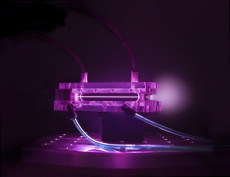Berkeley Lab Particle Accelerator Sets World Record
Simulations at NERSC Help Validate Experimental Laser-Plasma Design
December 9, 2014
Contact: Kate Greene, kgreene@lbl.gov, 510-486-4404

A 9 cm-long capillary discharge waveguide used in BELLA experiments to generate multi-GeV electron beams. The plasma plume has been made more prominent with the use of HDR photography. Image: Roy Kaltschmidt
Using one of the most powerful lasers in the world, researchers have accelerated subatomic particles to the highest energies ever recorded from a compact accelerator.
The team, from the U.S. Department of Energy’s Lawrence Berkeley National Lab (Berkeley Lab), used a specialized petawatt laser and charged-particle plasma to get the particles up to speed. The setup is known as a laser-plasma accelerator, an emerging class of particle accelerators that physicists believe can shrink traditional, miles-long accelerators to machines that can fit on a table.
The researchers sped up the particles—electrons in this case—inside a nine-centimeter long tube of plasma. The speed corresponded to an energy of 4.25 giga-electron volts. The acceleration over such a short distance corresponds to an energy gradient 1,000 times greater than traditional particle accelerators and marks a world record energy for laser-plasma accelerators.
“This result requires exquisite control over the laser and the plasma,” said Wim Leemans, director of the Accelerator Technology and Applied Physics Division at Berkeley Lab and lead author on the paper. The results were published December 8 in Physical Review Letters.
Traditional particle accelerators, like the Large Hadron Collider at CERN, which is 17 miles in circumference, speed up particles by modulating electric fields inside a metal cavity. It’s a technique that has a limit of about 100 mega-electron volts per meter before the metal breaks down.
Laser-plasma accelerators take a completely different approach. In the case of this experiment, a pulse of laser light is injected into a short and thin straw-like tube that contains plasma. The laser creates a channel through the plasma as well as waves that trap free electrons and accelerate them to high energies. It’s similar to the way that a surfer gains speed when skimming down the face of a wave.
The record-breaking energies were achieved with the help of BELLA (Berkeley Lab Laser Accelerator), one of the most powerful lasers in the world. BELLA, which produces a quadrillion watts of power (a petawatt), began operation just last year.

Computer simulation of the plasma wakefield as it evolves over the length of the 9-cm long channel.
“It is an extraordinary achievement for Leemans and his team to produce this record-breaking result in their first operational campaign with BELLA,” said James Symons, associate laboratory director for Physical Sciences at Berkeley Lab.
In addition to packing a high-powered punch, BELLA is renowned for its precision and control. “We’re forcing this laser beam into a 500 micron hole about 14 meters away, “ Leemans said. “The BELLA laser beam has sufficiently high pointing stability to allow us to use it.” Moreover, the laser pulse, which fires once a second, is stable to within a fraction of a percent, he added. “With a lot of lasers, this never could have happened.”
At such high energies, the researchers also needed to see how various parameters would affect the outcome. So they used computer simulations at the National Energy Research Scientific Computing Center (NERSC) to test the setup before ever turning on a laser. The fully self-consistent, multi-dimensional particle-in-cell (PIC) simulations they ran on NERSC's Cray XC30 supercomputer Edison have been fundamentally important to modeling the propagation of an high-intensity laser in the plasma, characterizing the nonlinear wakefield excitation and studying the details of particle self-trapping, according to Leemans.
"PIC simulations of the laser-plasma interactions are usually very computationally demanding," he said. "The computational power of Edison allowed us to perform extensive parameter scans, facilitating our understanding of the physics."
In order to accelerate electrons to even higher energies—Leemans’ near-term goal is 10 giga-electron volts—the researchers will need to more precisely control the density of the plasma channel through which the laser light flows. In essence, the researchers need to create a tunnel for the light pulse that’s just the right shape to handle more-energetic electrons. According to Leemans, future work will demonstrate a new technique for plasma-channel shaping.
“Small changes in the setup give you big perturbations,” said Eric Esarey, senior science advisor for the Accelerator Technology and Applied Physics Division at Berkeley Lab, who leads the theory effort. “We’re homing in on the regions of operation and the best ways to control the accelerator.
About NERSC and Berkeley Lab
The National Energy Research Scientific Computing Center (NERSC) is a U.S. Department of Energy Office of Science User Facility that serves as the primary high performance computing center for scientific research sponsored by the Office of Science. Located at Lawrence Berkeley National Laboratory, NERSC serves almost 10,000 scientists at national laboratories and universities researching a wide range of problems in climate, fusion energy, materials science, physics, chemistry, computational biology, and other disciplines. Berkeley Lab is a DOE national laboratory located in Berkeley, California. It conducts unclassified scientific research and is managed by the University of California for the U.S. Department of Energy. »Learn more about computing sciences at Berkeley Lab.







